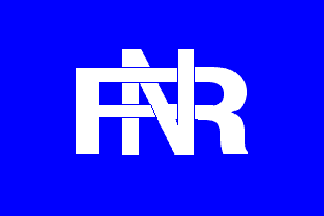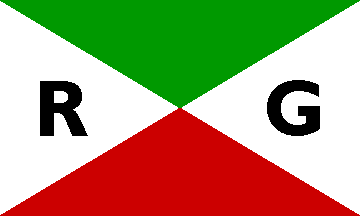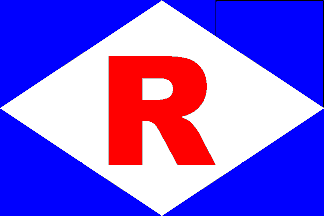
image by Eugene Ipavec, 29 April 2008

Last modified: 2008-08-02 by dov gutterman
Keywords: italy | houseflag | house flag |
Links: FOTW homepage |
search |
disclaimer and copyright |
write us |
mirrors
See also:

image by Eugene Ipavec, 29 April 2008
Ships List has a long page about this short-lived firm at <www.theshipslist.com>:
Founded by three brothers Raggio – one of them Emilio - at
Genoa in 1882 linking Italy and South
America, transporting passengers as well as
cargo. Rapidly developing, Raggio & Co. invested
heavily – too heavily – in new ships, all eleven of
which had to be sold to NGI,
another company interested in the South American run, in 1885.
Raggio wound up affairs in the same year. Later Edilio was to
found ‘Società Commerciale
Italiana di Navigazione’.
Griffin's 'Flags national and mercantile' of 1891 [gfi83] shows the house flag as no.182 (plate
12, steam vessels): flag of Genoa
(white, a red cross throughout), a red five-pointed star in the
upper hoist and a black initial ‘R’ (serifed) in the
lower one.
Jan Mertens, 28 April 2008
At the 1940
Spanish house flag source - the third one of the thirdrow has
been identified as 'Regia Azienda Monopolio Banane'.
Quote from<countrystudies.us>:
“By 1935 the Italian government had constituted a Royal
Banana Plantation Monopoly (Regia Azienda Monopolio Banane -
RAMB) to organize banana exports under state authority. Seven
Italian ships were put at RAMB's disposal to encourage the Somali
banana trade. After World War II, when the United Nations (UN)
granted republican Italy jurisdiction over Somalia as a trust
territory, RAMB was reconstituted as the Banana Plantation
Monopoly (Azienda Monopolio Banane - AMB) to encourage the
revival of a sector that had been nearly demolished by the
war.”
This account leaves out the colourful fate of some ships,
unimaginatively named RAMB I through IV, which on the outbreak of
war were equipped as auxiliary cruisers planning to hinder Allied
lines of support. RAMB I actually made it to the Indian Ocean
only to be stopped by HMNZS Leander whereas RAMB II reached Japan
only to be sunk at the end of WWII. RAMB IV became a
British hospital ship sunk by the Luftwaffe. Best of all fared
RAMB III since after a German stint it became Marshal Tito’s
property!
Source for the above: several articles on Italian Wikipedia
plus a few in English.
One further link at <www.aidmen.org>,
point us to an article in the ‘Rivista Marittima’ (in
Italian).
The image of the flag is
not very clear. On a dark blue field the shape of a yellow
eagle displayed can be made out; it is placed within a yellow
cartouche whereupon rests the royal crown, in full colour.
Possibly the eagle grasps a yellow fasces and/or surmounts the
initials ‘RAMB’. At <www.cosevecchie.com>,
the RAMB eagle is shown in
the lower left corner.
Jan Mertens, 16 January 2008
These were four identical ships that were built especially for
the RAMB, just before the war. In fact, war was already looming,
and they were designed to allow for refitting them as cruisers.
RAMB III had been shot at, torpedoed, mined (by herself), bombed,
and to add insult to injury, after she was salvaged for the
second time, they "rearranged her looks".
Actually, the crown is part of the "cartouche": the two
arc end on either side of the crown. The eagle "grasps"
the yellow fasces. (Well, it seems to be on "Is perched on
it"?) Whatever is on top of the fasces sinister of the eagle
in the logo is on the flag as well, but I can't make out the
exact shape. The letters appear to be below it, as the lower part
of the cartouche. The two arcs end at the height of the fasces
and what appear to be the letters "R.A.M.B" fill the
gap, following the circle. Only one dot is recognisable, mid
under, the same width as the arcs and exactly on the circle (or
the other way around). The letters are maybe two and a half times
that height, sticking out a bit on the outside, but more on the
inside. The M seems to stick out more, because one top would
otherwise collide with the fasces, but that's probably not a
feature. It does warn us that these small details we can barely
make out are not necessarily original.
Peter Hans van den Muijzenberg, 20 January 2008

image by Ivan Sache, 18 October 2003
The houseflag of Rimorchiatori Napoletani Srl (Naples,
Italy) is blue with combined "FNR" according to
<www.raccontare.com>.
Dov Gutterman, 18 October 2003

image by Jorge Candeias , 4 March 1999
Quartered per saltire, white at the hoist and fly, green at
the top and red at the bottom. A black "R"centered on
the hoist field and a black "G" centered at the fly
field.
Jorge Candeias, 4 March 1999
The full name of this subsidary is: Rimorchiatory Riuniti
Porto di Genova. It is a tugs company.
Dov Gutterman, 4 March 1999

image by Jorge Candeias, 2 March 1999
Quartered per saltire, the top quarter is green, the fly
quarter white charged with a black "R", the bottom
quarter is dark red and the hoist quarter white charged with a
black "R".
Jorge Candeias, 2 March 1999

image by Jorge Candeias, 4 March 1999
Quartered per saltire, white at the hoist and fly, green at
the top and red at the bottom. A black "R"centered on
the hoist field and a black "S" centered at the fly
field.
Jorge Candeias, 4 March 1999

image by Jarig Bakker, 19 September 2005
Soc. Rimorchi Salvataggi Trieste p.A. (SO. RI. SA.), Trieste -
red flag, a standing fould anchor between "SA", all
white (Same flag as Tripcovich).
Source: Brown's Flags and Funnels Shipping Companies of
the World, compiled by J.L. Loughran, Glasgow, 1995.
Jarig Bakker, 19 September 2005

image by Jarig Bakker, 13 July 2004
At home I have a stout "Larousse Commercial
Illustré" (a kind of trade encyclopedia) published in
Paris, 1930. It has four pages in colour illustrating house
flags; a note identifies it as the work of Sandy Hook.
In this book, I found "Roma" S. di Navigazione, Genova:
blue with white diamond touching the edges, a large red
serif-less letter 'R' in the centre. I estimate the letter
to be 1/2 of flag height.
Jan Mertens, 20 December 2003
Rubattino, once an important Italian shipping company, is
mentioned in the Navigazione Generale
Italiana section: [NGI] came about as a merger between
Ignazio & Vincenzo Florio (a firm from Palermo) and the
Società per la Navigazione a Vapore Raffaele Rubattino from
Genoa.
A short history is found at <www.chieracostui.com>,
alongside a picture of founder Raffaele Rubattino’s statue
at Genoa. We learn that the firm was founded in 1838 as De
Luchi-Rubattino and was the first Italian one to operate
steamships; name change in 1844 to ‘Società per la
navigazione de' battelli a vapore sul Mediterraneo’; assured
the connection between Genoa and Mediterranean ports (with postal
privilege, at least, to the Tuscan islands) extended to Morocco
and to East Africa after the opening of the Suez Canal (1869);
cooperated with Florio, leading to the 1881 merger: 43 Florio
steamers plus 18 (less, but much bigger) steamers of
Rubattino’s.
Rubattino, a personal friend of Cavour, proved to be an important
factor in modern Italian history, witness aiding Garibaldi in
invading (liberating) Naples by putting ships at his disposal
(1860) and establishing a coal bunkering port at Assab in Eritrea
(bought 1869, government property 1882) which would ultimately
lead to this country becoming an Italian colony in 1890.
Griffin's 'Flags national and mercantile' of 1891 [gfi83]: no. 188 (plate 12, steam
vessels) shows the house flag:
flag of Genoa (white, a red cross throughout) and word
‘POSTALE’ in black letters placed at the top taking up
one third of flag’s height.
The painting of Rubattino vessel ‘Polluce’, which sank
in 1841 at <www.hdsitalia.com>,
shows an undefaced Genoan
swallowtail. The word ‘Postale’ is lacking which
means that either the painting is not very detailed or no
faithful rendering, or else that we could be looking at a
precursor of the house flag in Griffin’s, predating the
postal privilege.
Sources: <it.wikipedia.org>,
<www.theshipslist.com>,
<www.calosci.com>
and <cronologia.leonardo.it>.
Jan Mertens, 11 May 2008